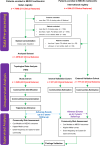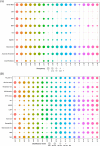The chronic heart failure evolutions: Different fates and routes
- PMID: 39318188
- PMCID: PMC11769638
- DOI: 10.1002/ehf2.14966
The chronic heart failure evolutions: Different fates and routes
Abstract
Aims: Individual prognostic assessment and disease evolution pathways are undefined in chronic heart failure (HF). The application of unsupervised learning methodologies could help to identify patient phenotypes and the progression in each phenotype as well as to assess adverse event risk.
Methods and results: From a bulk of 7948 HF patients included in the MECKI registry, we selected patients with a minimum 2-year follow-up. We implemented a topological data analysis (TDA), based on 43 variables derived from clinical, biochemical, cardiac ultrasound, and exercise evaluations, to identify several patients' clusters. Thereafter, we used the trajectory analysis to describe the evolution of HF states, which is able to identify bifurcation points, characterized by different follow-up paths, as well as specific end-stages conditions of the disease. Finally, we conducted a 5-year survival analysis (composite of cardiovascular death, left ventricular assist device, or urgent heart transplant). Findings were validated on internal (n = 527) and external (n = 777) populations. We analyzed 4876 patients (age = 63 [53-71], male gender n = 3973 (81.5%), NYHA class I-II n = 3576 (73.3%), III-IV n = 1300 (26.7%), LVEF = 33 [25.5-39.9], atrial fibrillation n = 791 (16.2%), peak VO2% pred = 54.8 [43.8-67.2]), with a minimum 2-year follow-up. Nineteen patient clusters were identified by TDA. Trajectory analysis revealed a path characterized by 3 bifurcation and 4 end-stage points. Clusters survival rate varied from 44% to 100% at 2 years and from 20% to 100% at 5 years, respectively. The event frequency at 5-year follow-up for each study cohort cluster was successfully compared with those in the validation cohorts (R = 0.94 and R = 0.84, P < 0.001, for internal and external cohort, respectively). Finally, we conducted a 5-year survival analysis (composite of cardiovascular death, left ventricular assist device, or urgent heart transplant observed in 22% of cases).
Conclusions: Each HF phenotype has a specific disease progression and prognosis. These findings allow to individualize HF patient evolutions and to tailor assessment.
Keywords: Cardiopulmonary exercise test; Heart failure; Prognosis; Topological data analysis.
© 2024 The Author(s). ESC Heart Failure published by John Wiley & Sons Ltd on behalf of European Society of Cardiology.
Conflict of interest statement
None declared.
Figures






References
-
- Pezzuto B, Piepoli M, Galotta A, Sciomer S, Zaffalon D, Filomena D, et al. The importance of re‐evaluating the risk score in heart failure patients: An analysis from the metabolic exercise cardiac kidney indexes (MECKI) score database. Int J Cardiol 2023;376:90‐96. doi:10.1016/j.ijcard.2023.01.069 - DOI - PubMed
-
- Agostoni P, Corra U, Cattadori G, Veglia F, La Gioia R, Scardovi AB, et al. Metabolic exercise test data combined with cardiac and kidney indexes, the MECKI score: A multiparametric approach to heart failure prognosis. Int J Cardiol 2013;167:2710‐2718. doi:10.1016/j.ijcard.2012.06.113 - DOI - PubMed
Publication types
MeSH terms
Grants and funding
LinkOut - more resources
Full Text Sources
Medical
Research Materials
Miscellaneous

